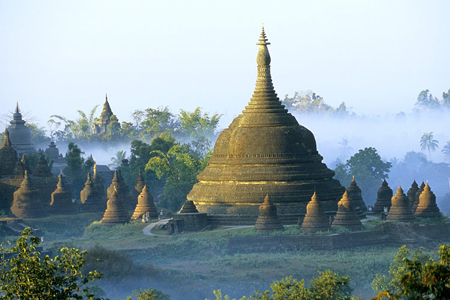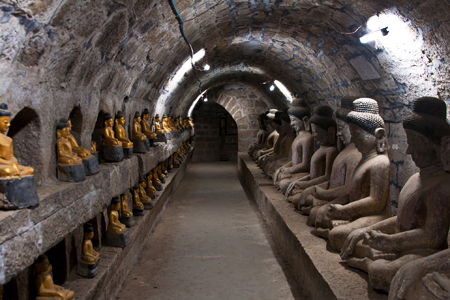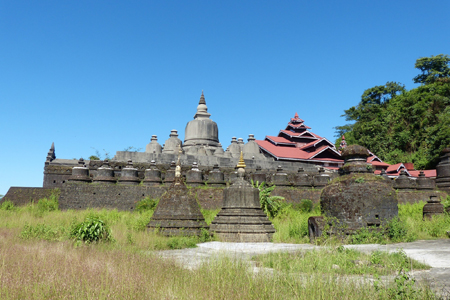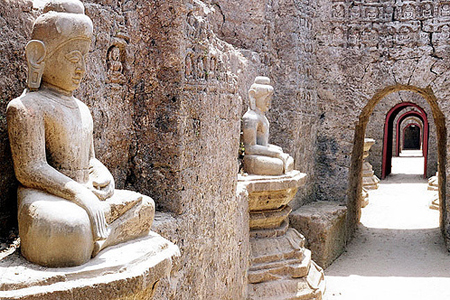Located in Rakhine State, the abandoned city of Mrauk U is a dream of any photographers who wish to capture the magical photos of fortresses which immerse into the smog. If you are planning for a tour in Myanmar and want to list Mrauk U into your itinerary, read out guides in this article to get the essential information about Mrauk U.
According to local chronicles, Arakan (Dinnyawadi) has a long history as an independent state from very early times before the Christian era. But we learn from a number of inscriptions and antiquarian remains that a Hindu or Hinduised dynasty was ruling at Wethali about the 2nd century B.C. It was succeeded by the Candra dynasty in the middle of the 4th century. There were 16 kings in this line and the total regal years were given as 230. Dven Candra (Taing Sandra) was the first king and the 16th and last was Dhrti Candra. After some years of interregnum there succeeded a third dynasty which lasted from the end of the 6th century to the beginning of the 8th century. Anandacandra, the last king of that dynasty, recorded the genealogical list of his predecessors in his Sanskrit inscription on a four-faced stone pillar originally set up in Vesali. Centuries later it was removed to the Shitthaung pagoda at Mrauk-U where it is now preserved. The chronicles give a much later date for the Candra dynasty but the inscriptions are corroborated by the coins of those kings. These early kings professed Mahayanism.

The Arakanese established themselves about the middle of the 10th century and soon after moved successively to the new capitals of Pyinsa, Parin, Hkrit and Launggyet. Their religion became more Hinayanist and by the 11th century Arakan became feudatory to Bagan. The Kings of Innwa tried to reassert their suzerainty and invaded Arakan in 1404. Minsawmun left Launggyet and took refuge in Bengal which was already under Moslem rule. When Nazi-ud-din became Sultan of Bengal in 1426 Minsawmun prevailed upon him to restore him to the throne of Arakan as his tributary, and after many years of exile he was ultimately re-instated in 1430. Three years later he shifted his capital and founded Mrauk-U. It remained the seat of the Arkanese rulers until 1785 when Arakan was invaded by Bodawpaya. The Arakanese kings of Mrauk-U, though Buddhists, saw fitting to use Mohammedan names in addition to their own names and even struck medallions bearing the Mohammedan confession of faith in Persian script.
Mrauk-U lies on the rocky plain or watershed between the Lemro and Kaladan rivers intersected by ranges of hills and numerous canals. The hills stone and brick, but those entirely built of stone are generally among the best preserved monuments at Mrauk-U. Shitthaung temple, lying on a hillock to the north of the palace site is more a fortress than a pagoda. The main edifice faces the steep, almost inaccessible hill on the east. The first terrace is reached by a flight of steps on the south. A covered path leads to the upper terrace which rises thirty feet above the lower court. On the west and south sides of the principal platform are stone walls 9 feet thick and originally 12 feet high. On the north and south walls are small brick pagodas, the gaps between them being filled with stone slabs sculptured in bold relief on both sides. Some of these slabs are still intact, while others have fallen down and are buried in the debris. The side of the slab facing the inner temple usually represents a Buddha, the outer side an ogre, naga or mythical birds or beasts. The inner temple court east of the main shrine is occupied by a wooden prayers hall which houses innumerable Buddha images. The shrine itself has a gallery all round the structure and a dark passage which leads to the inner chambers. The sanctum enshrining the main image is accessible through a passage opening from the east. Along the outer wall of the gallery are deposited hundreds of Buddha images of varying sizes.

The interior wall of the vaulted gallery is composed of three horizontal rows of ridges between alternating fillets cut into the stone surface. The ridges as well as the fillets running right round the central structure are decorated with sculptures in high relief. The figures represent kinnaras, birds and animals inthe lower rows and seated men holding flowers in the top row. At the corners are larger sculptures depicting scenes from the Jatakas. The temple is virtually a storehouse of sculptures exhibiting not only Buddhist, but also, to a lesser degree, Brahmanic influence. The superstructure of the temple is of brick. It is a cylindrical stupa with a square relic chamber between the dome and the finial. The temple was built by Minbin, also known as Minbagyi (1531-53).
Another fortress-like temple the Htukkhan-thein, built by King Minphalaung (1571-93) lies about 300 feet to the west of the Shitthaung. The structure stands on a hill, 30 feet high. It is reached by stone stairways on the east and south. Built of massive stone walls the basement pierced with small square holes has straight sides on the north, east and south, measuring 106 feet. The west side which is slightly convex is connected to an oblong chamber. The entrance on the east side, close to the south-east corner, leads to a long vaulted passage which spirals round in two tiers till it reaches the central chamber. The superstructure, a bell-shaped dome on receding terraces, is similar to that on the Shitthaung, but here a tall opening with square arch is provided on the east face to admit light into the central chamber. At each comer of the basement stands a small stupa. This temple is noted for the stone sculptures in the vaulted passages, especially the figures of seated ladies, with different styles of coiffure, in the attitude of offering lotus buds.

Close to the north of Shitthaung is the Andaw temple built by King Rajagyi (1593-1612). It is a small structure of stone lying on a hillock. The platform is accessible by flights of stairs on all sides except the west. The main shrine is octagonal in plan and faces east. There are two corridors round the central block which supports the octagonal stupa above. There are scores of seated stone Buddhas within niches cut into the interior walls which are decorated with arch-pediments and jambs finely carved in low relief. On the platform are small ruined stupas ranged along the enclosure walls and the walls of a rectangular prayer hall attached to the east side of the main shrine.
Mrauk-U abounds with numerous solid stupas also, largely built of hewn stone. The Yatanabon, built by King Minphalaung (1571-93) lies on a hillock to the north-east of the Shitthaung temple. The plan of its high plinth is octagonal with four long sides facing the cardinal points and four smaller sides at the comers. From the east side there projects a long quadrangle. There are no terraces and the bell-shaped body with three prominent mouldings round it rises directly from the plinth. The cylindrical dome is also low. It is topped by a short conical spire.

Examples of tall attenuated stupas in stone are to be found in the Sakya- man-aung, Yatna-nian-aung and Zina-man-aung pagodas. The Sakya-man- aung built in 1629 by Thirithudhammayaza has a unique plan in the form of a sixteen petalled lotus flower, the’petals being of three sizes : the largest four face the cardinal points while four medium sized petals and eight smaller ones are interspersed between them. This design is carried to the fourth terrace from the top of which rises the intermediate base, octagonal in plan. The bell is also eight sided. The total height of the pagoda is 117 feet.
The Yatna-man-aung built by Sandathudhammayaza in 1652 is 180 feet high. The base of this pagoda is also octagonal. The Zina-man-aung, 135 feet high, has a similar plan but the terraces have angular comers and there is a circular shrine within it, to which access is made by a long narrow passage opening to the east.
On the hills surrounding the town are countless square temples enshrining fairly large images of Buddha in stone. No proper excavation has yet been done at Mrauk-U nor at the earlier site of Wethali just a few miles north of it. But a large collection of ancient sculptures and inscriptions has already been made. Among the exhibits in the site museum may be seen a stone relief of Surya riding a chariot drawn by seven horses. This rare sculpture belonging to 8th century was discovered on the hill of Shin nge-det-taung at Mrauk-U. Other Brahmanical images are that of Vishnu and goddess Ganga with two dwarfs. From Tejarama monastery was found a square stone pillar three sides of which are ornately carved with standing figures of gods and goddesses in low relief. Several inscriptions in Sanskrit and Myanmar and a few in Persian or Arabic are also preserved in the museum, the most important among them being the epigraphs in mixed Sanskrit and Pali in North-eastern Nagari script of the 6th century dedicated by Niti Candra and Vira Candra.
